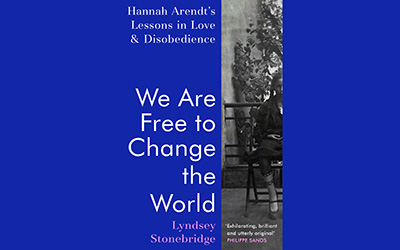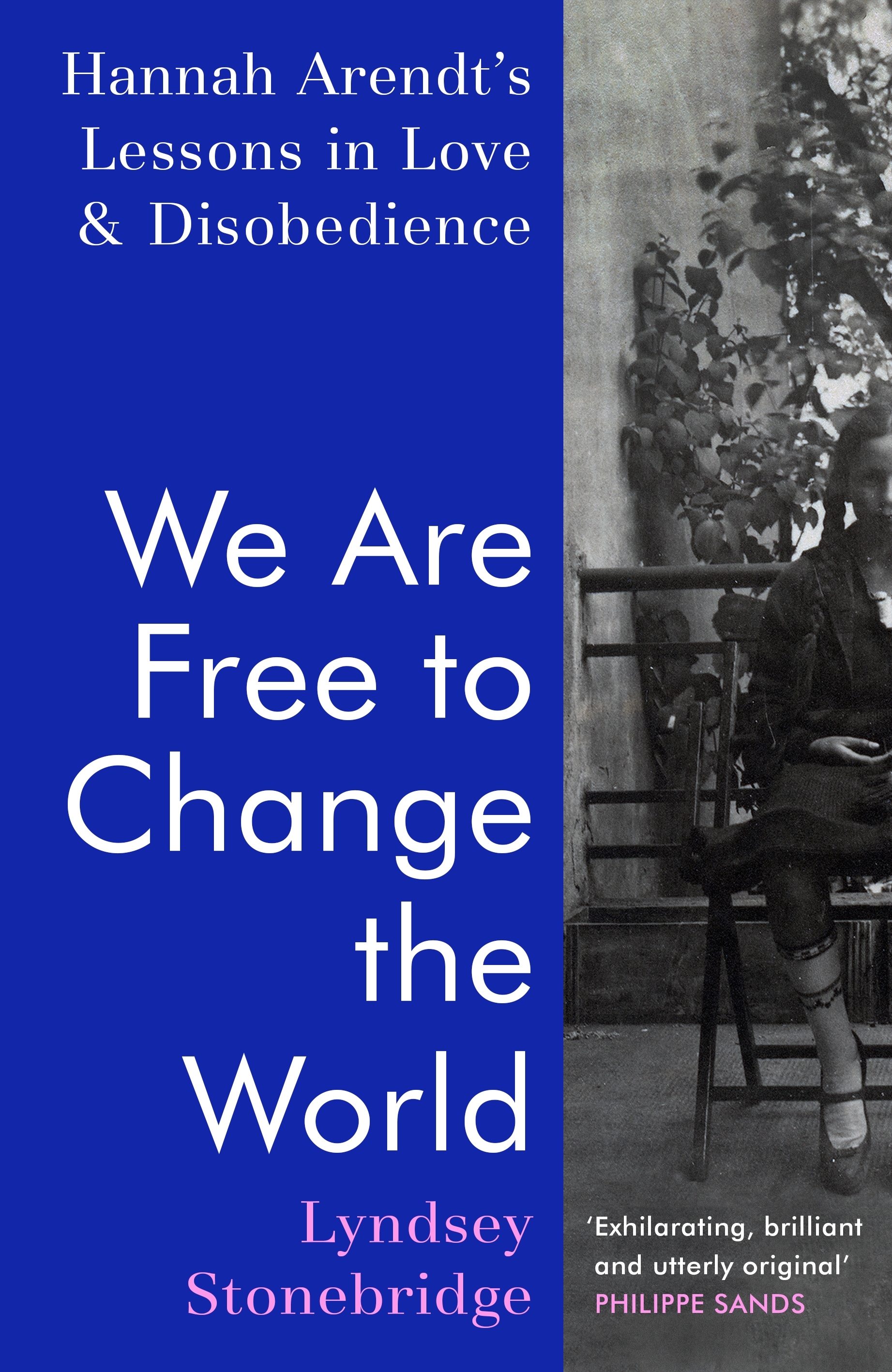
- Free Article: No
- Contents Category: Philosophy
- Review Article: Yes
- Article Title: An enlarged mentality
- Article Subtitle: Thinking imaginatively with Hannah Arendt
- Online Only: No
- Custom Highlight Text:
We Are Free to Change the World, an intellectual biography of Hannah Arendt, is Lesley Stonebridge’s seventh book, and is informed by the author’s expertise in twentieth-century literature, history, law, and political theory. Stonebridge is a Professor of Humanities and Human Rights at the University of Birmingham, and a regular contributor to the New Statesman. A successful scholar, she is also used to communicating to audiences beyond the academy.
- Featured Image (400px * 250px):

- Alt Tag (Featured Image): Julienne van Loon reviews ‘We Are Free to Change the World: Hannah Arendt’s lessons in love and disobedience’ by Lyndsey Stonebridge
- Book 1 Title: We Are Free to Change the World
- Book 1 Subtitle: Hannah Arendt's lessons in love and disobedience
- Book 1 Biblio: Jonathan Cape, $59.99 hb, 290 pp
- Book 1 Cover Small (400 x 600):

- Book 1 Cover (800 x 1200):

The ‘something more’ is signalled clearly with a preface titled ‘A Note on Imagination’. Stonebridge writes:
Hannah Arendt was committed to what Immanuel Kant called ‘an enlarged mentality’ which she believed to be the grounding for good judgement. This type of critical imagination is not creative, and nor is it necessarily empathetic. ‘You think your own thoughts but in the place of somebody else,’ she instructed her students. In this book I have tried to think my own thoughts in the place of Hannah Arendt. All direct quotations from her writing are in italics and referenced. I have imagined plausible scenarios in her life only where evidence permits. Despite these precautions, there may be moments in what follows when Hannah Arendt also thinks her thoughts in my place.
This preface is more than a note to suggest that Arendt’s words and phrases might enter the author’s lexicon. For me, Stonebridge’s note presents as an invitation, because I don’t yet understand how her use of ‘enlarged mentality’ as method is going to shape the form and meaning of the writing to come. I turn the page because I want to understand. To the extent, therefore, that Stonebridge’s book is intellectual biography, it could also be read as an enlarged or imaginative or intersubjective or experimental biography. It is worth noting that the book’s subtitle does not reference the genre of biography at all.
Hannah Arendt is an iconic twentieth-century thinker. Born in 1906 in Hannover, Germany, Stonebridge describes her as the ‘loved and cherished’ daughter of ‘educated, progressive, secular Jews’. Arendt began her intellectual education in Kant’s Königsberg: ‘Arendt grasped the radical simplicity of Kant’s central insight early and never lost sight of it,’ writes Stonebridge. ‘She would go on to challenge his cool rationality, but she never gave up on the importance of his central moral promise: because we have reason and moral agency we can, indeed we must, act to make the world a good place, whatever the cost.’
We Are Free to Change the World offers readers who are not experts on Arendt an immersive and thorough introduction to the woman and her thinking. The book opens with a convincing argument as to why, in our post-truth era, Arendt’s contribution to political philosophy is more important than ever. Stonebridge’s interest in making Arendt’s thinking relevant to our times is prioritised throughout.
In ten chapters, Stonebridge surveys Arendt’s best-known contributions to philosophy, including The Origins of Totalitarianism (1951), The Human Condition (1959), On Revolution (1963), Eichmann in Jerusalem (1963), Crises of the Republic (1972), and The Life of the Mind (1978), mostly in chronological order. Stonebridge highlights the key events that shaped Arendt’s thinking, such as her relationship with her philosophy professor – one Martin Heidegger – at the age of eighteen. ‘Thinking was existence itself. Thinking was passion – and passionate,’ she writes on this phase of Arendt’s life. Then follows Arendt’s period of flight as a refugee: ‘In 1938, following the Nuremberg Laws, Arendt was formally stripped of her citizenship … Statelessness was a new weapon in the modern armory of twentieth-century human cruelty.’ Later, Stonebridge chronicles Arendt’s migration to New York via Paris and Lisbon, and then her journey back to Europe to cover the trial of Eichmann, a commission for The New Yorker.
Stonebridge defends a number of charges made against Arendt and her thinking during her lifetime, some of which had more to do with her gender than her intellect. She stakes a claim for her enduring contribution to modern thought:
She was one of the first, in fact one of the few European intellectuals to grasp that the organised barbarity of modern totalitarianism was not an aberration belonging only to Nazi Germany or Soviet Bolshevism but was a piece with a longer imperial and colonial history of dog kicking and dog burying.
But this is no hagiography. Stonebridge’s own thinking comes at the reader lively and lucid on every page. She questions Arendt’s motivations where necessary and calls her to account, particularly in the chapter titled ‘How to Think – And How Not to Think – about Race’, in which Arendt’s judgement on matters to do with race in her newly adopted country, especially her writing on the actions of teenager Elizabeth Eckford (one of the Little Rock Nine who dared to take up her lawful place at the previously segregated Central High), fall achingly short of her own standards.
Emblematic of the success of We Are Free to Change the World are those sections of prose in which we witness Stonebridge thinking with Arendt. This occurs not just within the bounds of Arendt’s biographical life story, but beyond it, as demonstrated in her discussion of Arendt’s influence on a new generation of revolutionaries during the struggles in Lebanon in 2019, as well as her portrait of Hannah Arendt Haus, a library dedicated to ‘stories of flight, of new beginnings and of resistance’ that has sprung up in Arendt’s birthplace of Hannover.
Mary McCarthy, a long-time friend of Arendt and an early reader of the manuscript that became The Origins of Totalitarianism, wrote in a letter to Arendt of her enthusiasm for the work, describing it as ‘engrossing and fascinating in the way a novel is, i.e. that it says something on nearly every page that is novel, that one could not have anticipated from what went before but that one then recognises as inevitable and foreshadowed by the underlying plot of ideas’. I think the same could be said of Stonebridge’s accomplishment with We Are Free to Change the World. I cried at the end. ‘Real freedom,’ concludes Stonebridge, channelling Arendt, ‘requires the presence of others so that we can test our sense of reality against their views and lives, make judgements, probe and learn.’ It is this courageous agonism – both respectful and open-ended, or, to use the keywords from Stonebridge’s subtitle, both loving and disobedient – that is central to Arendt’s vision for an affirmative and inclusive politics.
I am a slow reader, largely because my reading time tends to be confined to those precious minutes outside paid and domestic labour obligations, early morning and late evening, when the world quietens, and thinking and reading can happen in solitude and with minimal interruption. It takes me a few weeks to finish a book like We Are Free to Change the World. The test of a book’s quality or ‘fit’ for me as a reader can often be measured by whether it occupies me during the day and, relatedly, whether I am looking forward to returning to its world in the evening. In the case of Stonebridge’s imaginative/intellectual biography, I felt both occupied and called back every single day. Was it Hannah Arendt’s thinking I sought to be reunited with, or was it Lesley Stonebridge’s imaginative play with Arendt’s thinking? The answer is both/and.


Comments powered by CComment